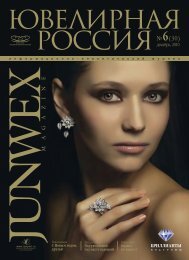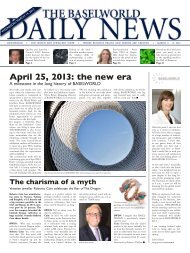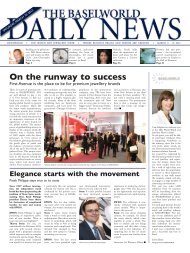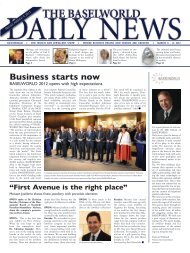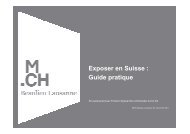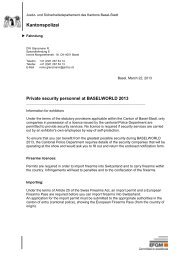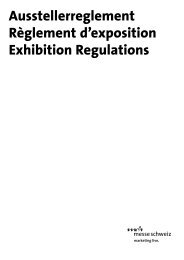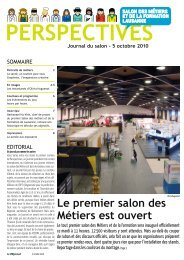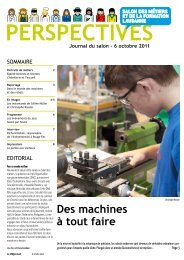WatchTime - August 2012
WatchTime - August 2012
WatchTime - August 2012
Create successful ePaper yourself
Turn your PDF publications into a flip-book with our unique Google optimized e-Paper software.
TEST<br />
Zenith Pilot Big Date Special<br />
t the beginning of the 20th century, pilots’<br />
watches were essential tools for aviators.<br />
In 1909, the first aviator to cross the English<br />
Channel, Louis Blériot, used a Zenith<br />
wristwatch with a rotating minutes<br />
marker during his 37-minute flight.<br />
Shortly thereafter the first cockpit instruments<br />
came into use. Zenith equipped<br />
airplanes with altimeters and other aviation<br />
instruments that eventually made pilots’<br />
watches unnecessary. Zenith was also<br />
a major supplier of temperature-resistant<br />
and anti-magnetic aircraft clocks in<br />
the 1930s and ’40s.<br />
Today, pilots’ watches serve as emergency<br />
backup instruments for recreational<br />
aviators. But, of course, most pilots’watch<br />
fans aren’t pilots at all, but earthbound<br />
types who like the watches’ distinctive<br />
styling.<br />
The Zenith Pilot Big Date Special<br />
combines the historical, functional design<br />
84 <strong>WatchTime</strong> <strong>August</strong> <strong>2012</strong><br />
of a pilots’ watch with several new elements.<br />
The watch has typical pilots’watch<br />
features: a black dial to limit light<br />
reflection, luminous displays, satin finishes<br />
on the case, and a calfskin strap with<br />
contrasting white stitching.<br />
However, Zenith has made<br />
some interesting changes to<br />
the dial. Unlike a classic pilots’-<br />
watch dial, the dial of<br />
the Zenith Pilot Big Date<br />
Special features several<br />
finely calibrated tracks and<br />
incremental markers between<br />
the minutes indices.<br />
The numeral 12 appears in<br />
place of the usual triangle<br />
with two dots.<br />
The watch has more features than a<br />
traditional pilots’ watch. In addition to<br />
the time display, the watch has a chronograph,<br />
a patented big-date display and a<br />
telemeter scale, which calculates distances<br />
by using the speed of sound. You<br />
can start the chronograph when you see a<br />
bolt of lightning and stop it when you<br />
hear the thunderclap – the chronograph<br />
seconds hand will show how far away the<br />
storm is in kilometers.<br />
As on many Zenith watches, the date<br />
display, rather than the hour counter, is at<br />
the 6 o’clock position. To make the two<br />
large date disks as compact as possible,<br />
Zenith has placed them very close together<br />
and uses the right disk for the tens digit<br />
rather than the left one (see photo detail<br />
on the next spread). The tens disk has rectangular<br />
openings through which the single<br />
digits can be seen. The design is clever<br />
but it doesn't solve the age-old problem<br />
of having the disks on different levels,<br />
which allows shadows to fall on the lower<br />
disk, making it hard to read. (Several<br />
other watches in Zenith's collection use<br />
big-date displays in which both numerals<br />
are on the same level.)<br />
The date numerals on the Pilot Big<br />
Date fill the openings so fully that they almost<br />
touch the edges. They tend to blend<br />
in with the black dial, which also makes<br />
the date difficult to read. In addition, the<br />
right digit on our test piece was always<br />
slightly misaligned. And purists might<br />
find fault with the different styles of type<br />
used for the date and the other numerals<br />
on the dial.<br />
The most important added function<br />
this watch offers is a chronograph, which<br />
is based on the renowned El Primero caliber.<br />
The minutes counter, which is easy<br />
THE PUSHERS ARE EASY<br />
TO USE, BUT THERE IS A<br />
NOTICEABLE JUMP WHEN<br />
THE CHRONOGAPH’S<br />
SECONDS HAND IS STARTED.<br />
to read, is at 3 o’clock. However, it’s<br />
harder to read the chronograph seconds<br />
hand because the seconds markers and<br />
partial-seconds markers are a little difficult<br />
to tell apart. This is especially true at



